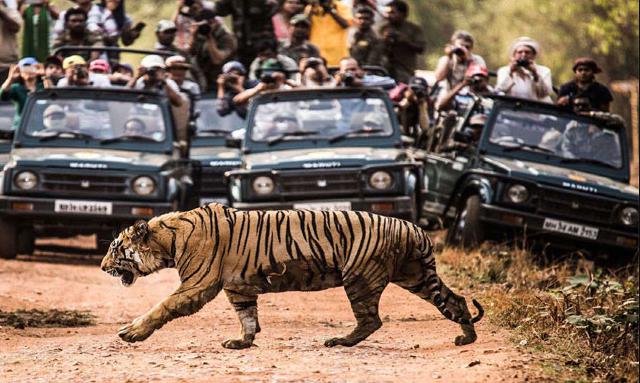Impact of Tourism on Tiger
Also Read: Balloon Safari In Bandhavgarh Tiger Reserve Creates Controversy
The study revealed that these iconic carnivores suffer from high levels of physiological stress due to wildlife tourism and a large number of vehicles entering the parks. Prolonged stress can adversely affect both survival and reproduction, it found. “Chronically elevated glucocorticoid levels can negatively impact growth, reproductive success, immunity, and cause muscular atrophy,” senior author Govindhaswamy Umapathy who was principal scientist and project leader wrote. “If it continues it will have a definite impact on the population in the long-term.” Interestingly, a previous study by the authors, published in 2015, showed that tigers re-introduced in Sariska Tiger Reserve in Rajasthan in 2008 failed to reproduce, probably due to stress elicited by human disturbances. As the conservationists are concerned over the impact of tourism on tigers, eco tourism has gone up manifold over the past few years. For the study the researchers had collected 206 tiger fresh scat samples during the tourism period between January and March and the non-tourism period, the month of September. From these samples, they extracted glucocorticoid metabolites—steroid hormones that are released when the animals are stressed.
It’s Myth That Tiger Breeds only in Monsoon
Most of the state government sight tiger breeding in monsoon as the reason behind the monsoon break. Contrary to the myth, tigers breed round the year. “Except when raising a litter, a tigress comes into oestrus ( a recurring period of sexual receptivity and fertility in many female mammal) every 21 days. Even in the event of stillbirth or premature death of cubs, it comes into heat again within a month”, scientists said. On the contrary, they claimed, the rainy season was not the best time for tiger breeding. While elephant breeding is indeed linked to rainfall patterns — they breed round the year in places where it rains likewise — a high number of births are observed in the winter months of November-January in India, indicating a surge in mating in the pre- and early monsoon months of May-July.
Also read: Coal Mining All Set To Threaten Tiger Corridors Around Tadoba
A study in 2009 on reproductive behaviour of elephants in Rajaji revealed that the musth phenomenon in adult male elephants was mostly observed during February to July, which was dominated by dry period and peak breeding season in largely the warm period starting May. Monsoon may not be the best season for tiger breeding but a number of species do breed in the forest during the rainy months and together they maintain the ecological balance, or the food chain, that supports the apex species.
So Why National Parks Remain Closed in Monsoon
The main reason why the parks are closed down during the monsoon is the risks involved in driving inside the jungle and stay in forest resorts and hotels . Jim Corbett National Park banned the night stay in several tourist zones of the park from June 14 due to monsoon. “They will resume the services from November 15 so that tourists can enjoy the park thoroughly again”, the park authorities announced before the jungle was shut down. The rainfall washes off the jungle pathways, rivulets overflow and the undergrowth grows fast and should remain intact. “In fact the jungles makeover during the monsoon and would wish to do it in the absence of humans”, said a park director in Uttarakhand where a minister had announced in 2021 to open Corbett and Rajaji national round the year. Monsoon in Assam forces Kaziranga National Park to stay practically shut for six months between May and October. A tropical forest is least accessible during the monsoons.
Also read: Where Did Ranthambore Tigers Vanish ? NTCA Must Find An Answer
But meagre rainfall in Rajasthan allows Ranthambhore National Park to stay open for 9 months between October and June. Though it rains heavily in Madhya Pradesh , the state is also following the same time table. Nagarhole and Bandipur Tiger Reserves of Karnataka are closed down to tourists in the dry summer season to protect animals from stress and the forests from fire. But the absence of tourism is linked safety of tiger. The hustle bustle of tourism keeps the poachers at bay. The poacher considers the monsoon an opportunity when guards struggle to patrol much of the reserve. That is why Project Tiger has always emphasised enhanced vigilance during the monsoon. I think you need to strike a balance between ecology preservation and economics of tourism.





Comments
Post a Comment